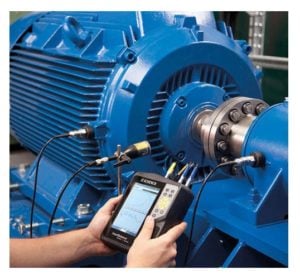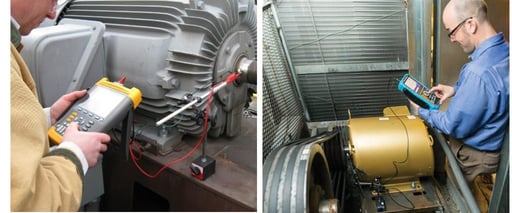Part 16 in a series of questions and answers from our Q&A webinars.
Q1. Can we diagnose the presence of shaft voltage based on vibration analysis?
A1. You can detect electrical bearing damage with vibration analysis, but only after it's occurred. You need an oscilloscope to measure shaft voltage in some way. The usual way is to capture the shaft voltage waveform to look for discharges with an ordinary oscilloscope. Or you can use a more specialized tool like the Beppe which automatically detects and counts discharges.
Q2. How can you diagnose whether a motor bearing needs to be protected, and what would you see on a bearing that failed due to electrical damage?
A2. Shaft voltage testing, by whatever means, will show you whether a bearing is at risk. In some cases, you can also use an electrical discharge detector. In our experience though, discharge detectors don't work well with small motors. In either case, the testing is all done online, while the motor is running.
If the bearing has already failed, you will need to cut it, examine the grease, and see what the balls and inside of the raceways look like. In case of electrical damage, the grease will usually be black from charring and contamination with metal particles. And the race will have visible damage ranging from frosting to fluting. Both are easy to see. Frosting shows as a matte band, very distinct against the mirror-smooth finish of the rest of the race. And fluting shows as regular striping occurring in a frosted band. In either case, the rolling elements will typically also be frosted.
Q3. Do I need to use the AEGIS Shaft Voltage Tester to measure shaft voltage, or can I use my own oscilloscope?
A3. Like TVs or VCRs (remember those?), oscilloscopes all work pretty much the same. The one catch is that you need a scope with at least 100 MHz bandwidth. Shaft voltage buildup, and especially discharge, are fast phenomena. A scope's bandwidth is a measure of its ability to measure high-speed/high-frequency events.

The higher the bandwidth, the more accurate at low timescales/high frequencies. We've found that 100 MHz is enough, and that's the Shaft Voltage Tester's bandwidth. Higher bandwidth is good, but you don't need to go out and buy a 500 MHz scope when 100 MHz is fine. If you do use a non-AEGIS oscilloscope, you will need some type of special probe tip. We offer the SVP-TIP-9100 3-pack of probe tips, which fit our own and some Fluke probes. We also offer a 10:1 probe plus tip combo pack, the AEGIS-SVP-510. The probe has a BNC connector so you can use it with any oscilloscope with BNC ports. You can see all of our shaft voltage testing accessories here.
AEGIS Shaft Grounding Rings come with a 2-year extended warranty against bearing fluting damage. No other form of protection against VFD-caused bearing damage offers a warranty like this.
To learn more about AEGIS shaft grounding and best practices for electrical bearing protection, sign up for a training. We offer monthly live training webinars, and - pandemic restrictions permitting - we can also visit your facility to review your exact application.



